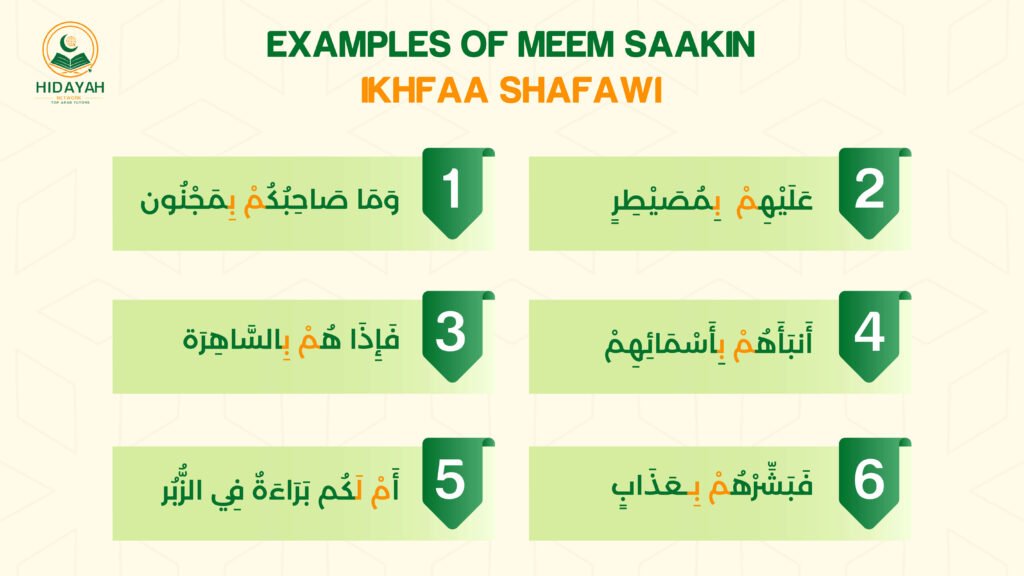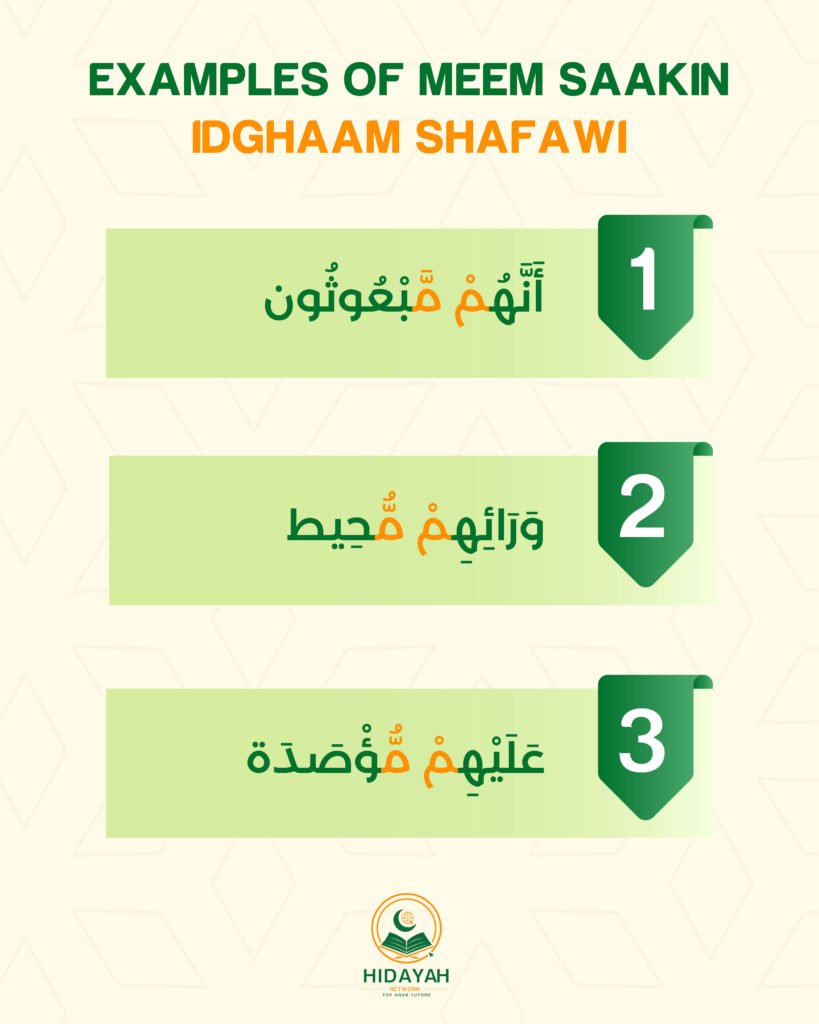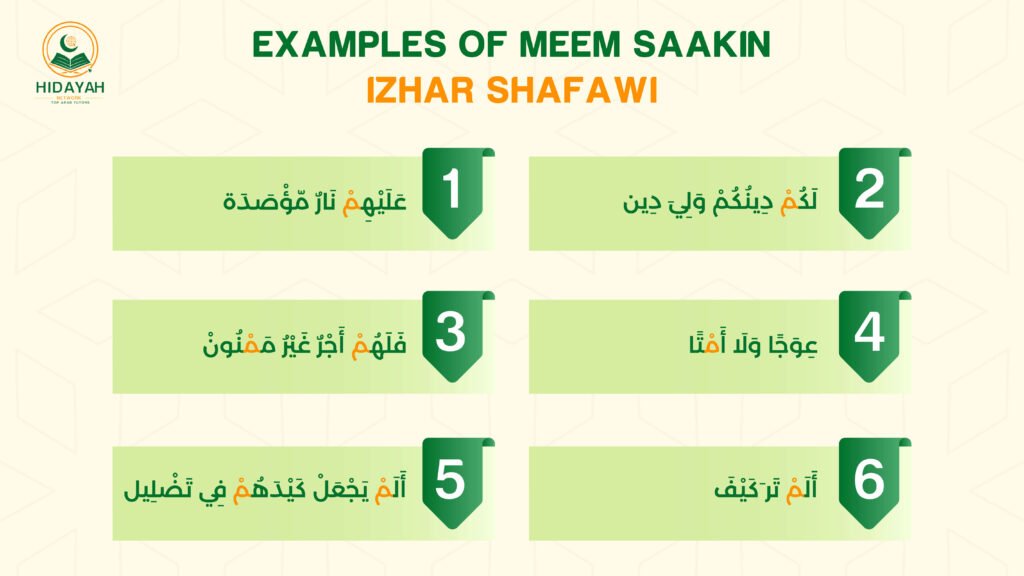Learning the rules of Tajweed requires patience to master it. Each rule has its significance, and if you want to be exceptional in your makharij, you must pay attention to each rule. Some rules take time to understand and practice, while others are easily applicable. You must find relevant examples from the Quran, apply the rule, and recite it 5-10 times.
Today, I would like to explain one of the most significant Tajweed rules, the Meem Sakinah. Some alphabets have their own separate identity, while the rest of the letters correspond with them. Skim through this blog to learn about Meem Sakinah.
Table of Contents
ToggleWhat is meem Sakinah?
Meem is one of the letters from the Arabic alphabet and sakinah means stopping or having no movement. So, when the letter meem has none of the 3 short vowels (fatha, dammah, and kasra), it will have a sign of sakinah or jazm. If Meem has any of the short vowel movements on it, it will not be considered as meem sakinah.
The meem sakinah can appear in the middle or at the end of the word. It can come in nouns and verbs. If you want to learn Tajweed rules efficiently, then practice the rules of Meem sakinah and apply them accurately.
Here’s what doesn’t count as Meem Sakinah:
- Meem with a vowel or Harakah on it: For example, in (نَارُ الله المُوقَدَة), the Meem has a vowel, so it’s not Sakinah.
- Meem with Shaddah: In (مُحَمَّدٌ رَسُولُ الله), the Meem has a Shaddah, not Sakinah.
- Meem that becomes Mutaharrik to avoid two successive Sukoon: In (تَجْرِي مِن تَحْتِهمُ الأَنْهَار), the Meem moves to avoid two Sukoons, so not Sakinah.
Now, what Rasulullah SAW said about reciting the Quran is inspiring:
“A believer who recites the Qur’an is like a citron whose fragrance is sweet and whose taste is sweet” (Mishkat Al-Masabih).
This underlines the profound benefits of engaging with the holy Quran.
Get 40% OFF Now!
What are meem sakinah rules?
There are 3 rules applicable to Meem Sakinah:
- Ikhfaa Shafawi
- Idgham Shafawi
- Izhar Shafawi
These rules are verily found in the Quran and if learned correctly, will help you improve your tajweed.
1- Ikhfaa Shafawi
Ikhfaa in Arabic means “to hide or disappear” and Shafawi refers to “lips”. When a word ends with meem sakinah and is followed by the letter “baa”, the reciter is supposed to hide the sound of meem in lips by uttering a nasal sound (ghunna). This rule is the same as Iqlab in Noon Sakinah where its sound is converted into the sound of Baa.
Ikhfaa shafawi examples in the Quran
Let’s have a look at the following examples that have Ikhfaa shafawi in them:
- وَمَا صَاحِبُكُمْ بِمَجْنُون
- عَلَيْهِمْ بِمُصَيْطِرٍ
- فَإِذَا هُمْ بِالسَّاهِرَة
- أَنبَأَهُمْ بِأَسْمَائِهِمْ
- أَمْ لَكُم بَرَاءَةٌ فِي الزُّبُر
- فَبَشِّرْهُمْ بِــعَذَابٍ
In these examples, the reciter will pronounce meem sakinah with a blend with the letter Baa and hold for ghunna for 2 seconds.

2- Idghaam Shafawi
Idgham in Arabic means “to merge or consolidate into another”. In tajweed, it means to merge the sound of one letter into the sound of the other to make it one weighted letter.
Idgham shafawi occurs when meem sakinah is followed by meem Mushaddad to make it one letter.
This type of Idgham is called Idgham Mithlain Sagheer because one of the two letters involved is silent, while the other has the same attributes as Harakah, Makhraj, and Sifah. “Mithlain” means “the same as the other,” and “Sagheer” emphasizes that the first letter is not a vowel, and the second one is.
The vowelless Meem meets the Meem with a Harakah in the other letter. When they join forces, a nasal sound called “Gunnah” is produced, creating a strong connection between the two Meems and giving voice to the previously silent one.
Idgham shafawi examples in the Quran
The following examples are taken from Quranic verses to make the rule understandable:
- أَنَّهُمْ مَّبْعُوثُون
- وَرَائِهِمْ مُّحِيط
- عَلَيْهِمْ مُّؤْصَدَة
In these examples, a silent meem is preceded by meem mushaddad which is why the reciter will merge the sound.

3- Izhar Shafawi
Izhar means “clear and exposed”. In tajweed, it means to pronounce the letters followed by meem sakinah. Izhar shafawi has 26 letters excluding ‘baa’ and ‘meem’ as these letters are from Idgham and Ikhfaa.
Izhar Shafawi examples in the Quran:
Let’s look at the examples to get this rule clearly understood:
- عَلَيْهِمْ نَارٌ مّؤْصَدَة
- لَكُمْ دِينُكُمْ وَلِيَ دِين
- فَلَهُمْ أَجْرٌ غَيْرُ مَمْنُون
- عِوَجًا وَلَا أَمْتًا
- أَلَمْ يَجْعَلْ كَيْدَهُمْ فِي تَضْلِيل
- اَلَمْ تَرَکَیْفَ
You can see in these instances, Meem is silent and is followed by other letters like Taa and Daal. That is why we will pronounce the sound and the lips will remain close.

3 Different Ways to Apply Meem Sakinah
Here’s how to apply Meem Sakinah in different ways:
1. Idgham Shafawi with Ghunnah (Meem Sakinah + Another Meem)
Idgham Shafawi involves the merging of Meem Sakinah with another Meem, accompanied by Ghunnah. Consider the verse (وَالْمُؤْمِنُونَ وَالْمُؤْمِنَاتُ بَعْضُهُمْ أَوْلِيَاء بَعْضٍ ۚ يَأْمُرُونَ بِالْمَعْرُوفِ وَيَنْهَوْنَ عَنِ الْمُنكَرِ), where the Meem Sakinah in “مُؤْمِنُونَ” merges seamlessly with the following Meem, accompanied by Ghunnah.
2. Iqlab Shafawi with Ghunnah (Meem Sakinah + Letter Ba)
Iqlab Shafawi occurs when Meem Sakinah encounters the letter ب (ba), resulting in a subtle change with Ghunnah. For instance, in the phrase (وَمِن شَرِّ حَاسِدٍ إِذَا حَسَدَ), observe how the Meem Sakinah in “حَاسِدٍ” undergoes Iqlab when meeting the following ب, accompanied by Ghunnah.
3. Izhar Shafawi Without Ghunnah (Meem Sakinah + Any other letter)
In Izhar Shafawi, Meem Sakinah stands boldly without any Ghunnah, clearly pronounced before any letter except ب (ba) and م (meem). For example, in the phrase (قَدْ جَاءَكُم مِّنَ اللَّهِ نُورٌ), notice how the Meem in “مِّنَ” is distinctly articulated without Ghunnah.
Conclusion
All the rules are easy to learn but you can only maintain them and get perfect in Tajweed with continuous practice. Meem Sakinah rules can easily be applied to the surahs in 30th juz. Recite the surahs with Tajweed to attain mastery level. Grab a slot in Hidayah Network’s free trial and learn all the tajweed rules from proficient Egyptian tutors.
The Most Important Questions
What is meem sakinah in Arabic?
Meem sakinah is a significant rule of tajweed that is applicable while reciting the Quran. In this rule, the reader will observe the meem sakinah in 3 conditions.
How many cases of Meem sakinah are there?
There are 3 cases of meem sakinah 1. Izhar Shafawi. 2. Idgham Shafawi. 3. Ikhfaa Shafawi.

About Author
Related Blogs
Dive Deeper into Related Topics

